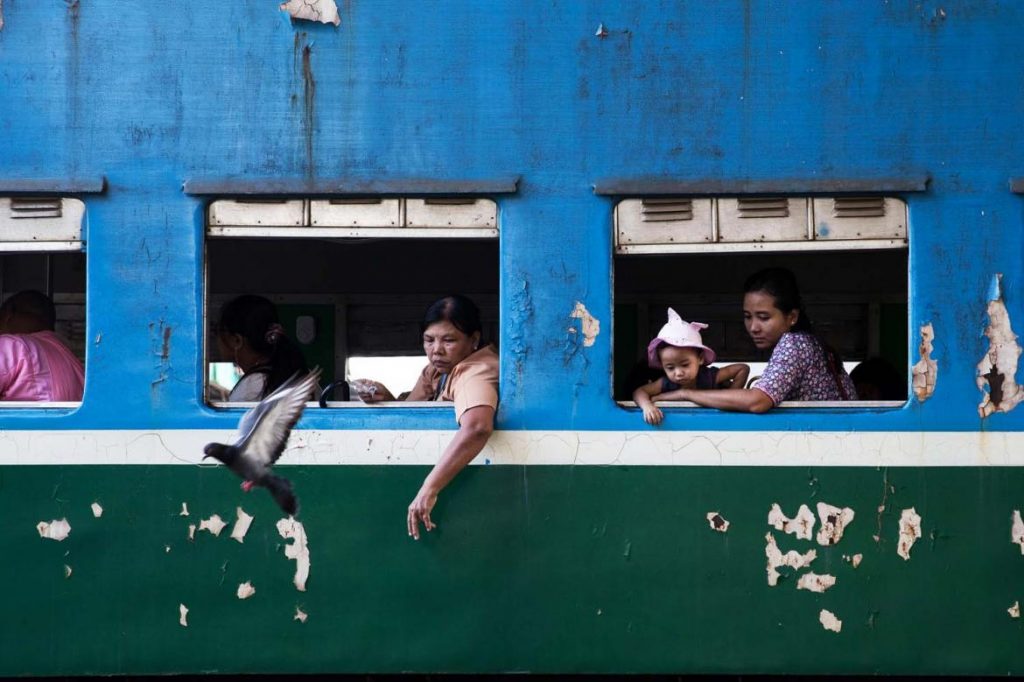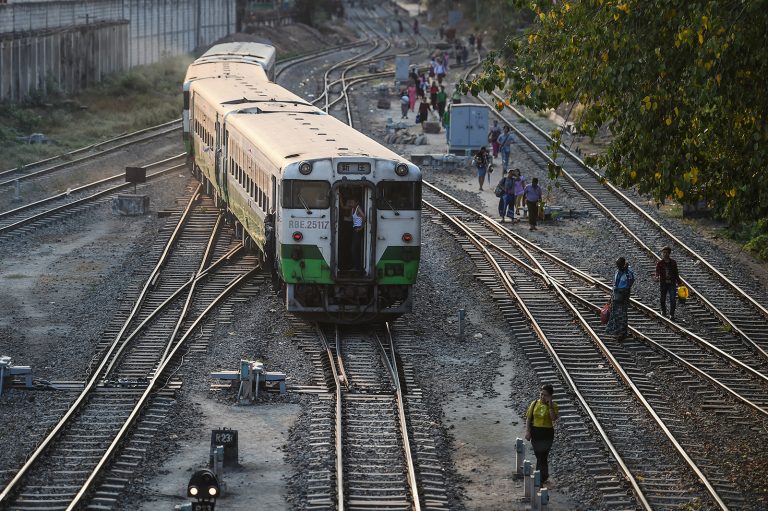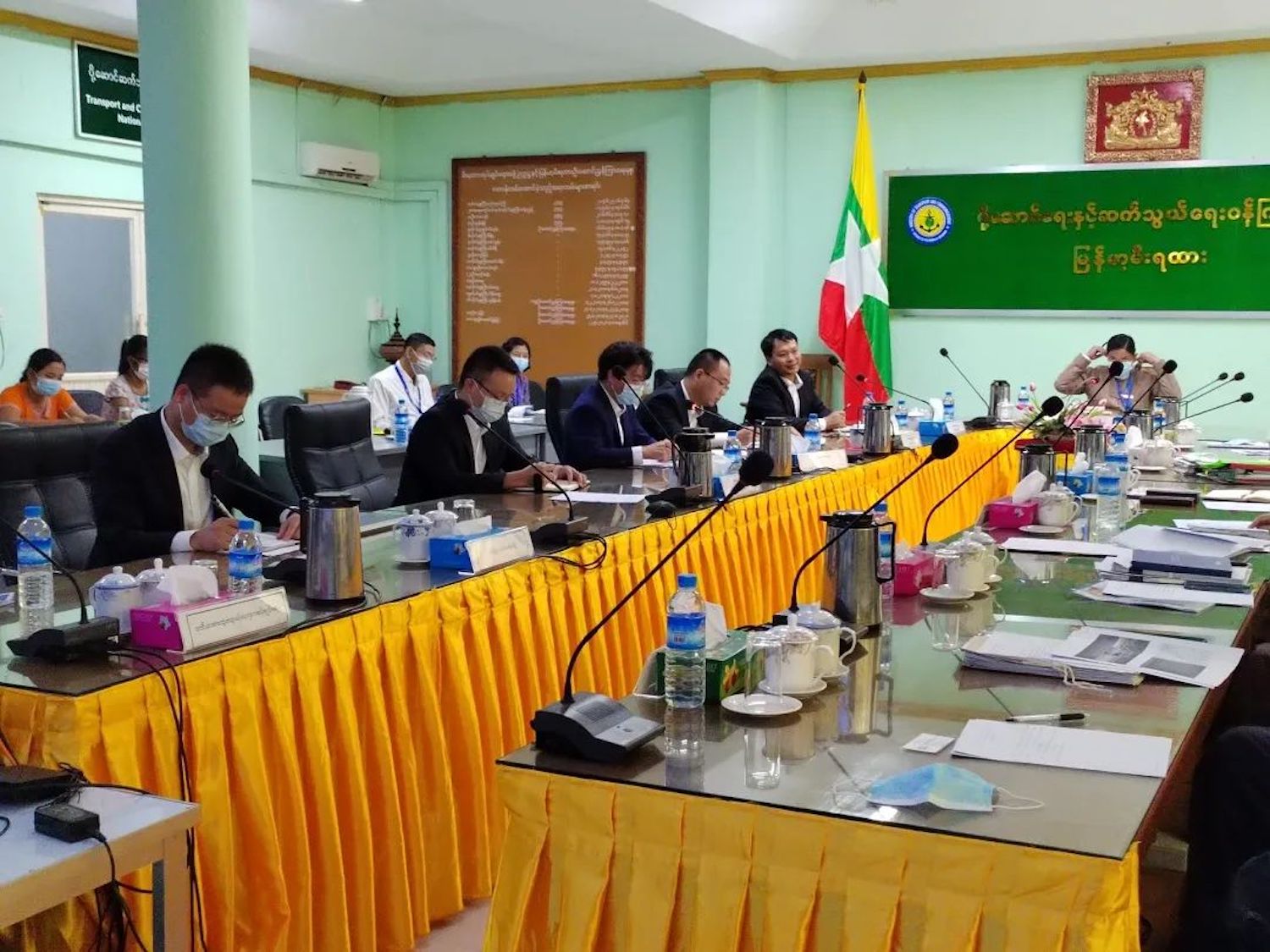Yangon’s Circular Railway is receiving a much-needed upgrade, but efforts to control vendors risk depriving hundreds of people of their livelihoods.
By HEIN THAR | FRONTIER
Photos NYEIN SU WAI KYAW SOE
A RIDE on Yangon’s Circular Railway offers a fascinating if bumpy tour around the commercial capital in the company of passengers from all walks of life, including commuters, vendors and beggars.
The 46-kilometre line, with 38 stops, also provides a glimpse of the daily lives of the city’s residents during a round-trip that passes through satellite towns and suburbs, some very poor, that takes about three hours. The round-trip fare for Myanmar is K100 and foreigners pay K300.
The Circular Railway began operating in 1954. For most of its 65 years, improvements to service have been slow. U Zaw Lwin, the traffic manager of the Circular Railway, told Frontier that 13 of the 21 trains on the route are more than 50 years old. The few improvements to carriages include the replacement of old, broken wooden seats with those made of fibreglass.
The old trains need careful handling. “Since the trains are very old, we have to drive carefully using our many years of experience,” said U Hla Win, an engine driver on the Circular Railway for 20 years. “The brakes of some coaches are unsafe, so before we stop at stations, we have to reduce speed far ahead.”
Support more independent journalism like this. Sign up to be a Frontier member.
Reducing speed on the Circular Railway often means slowing to a walk because the average running speed is 20 miles an hour (32 kilometres an hour).
State-owned Myanma Railways says the train is used daily by about 90,000 commuters, who would surely appreciate faster and punctual service, and about 150 foreigners, who take the train for fun or a leisurely opportunity to see the sights along the tracks.
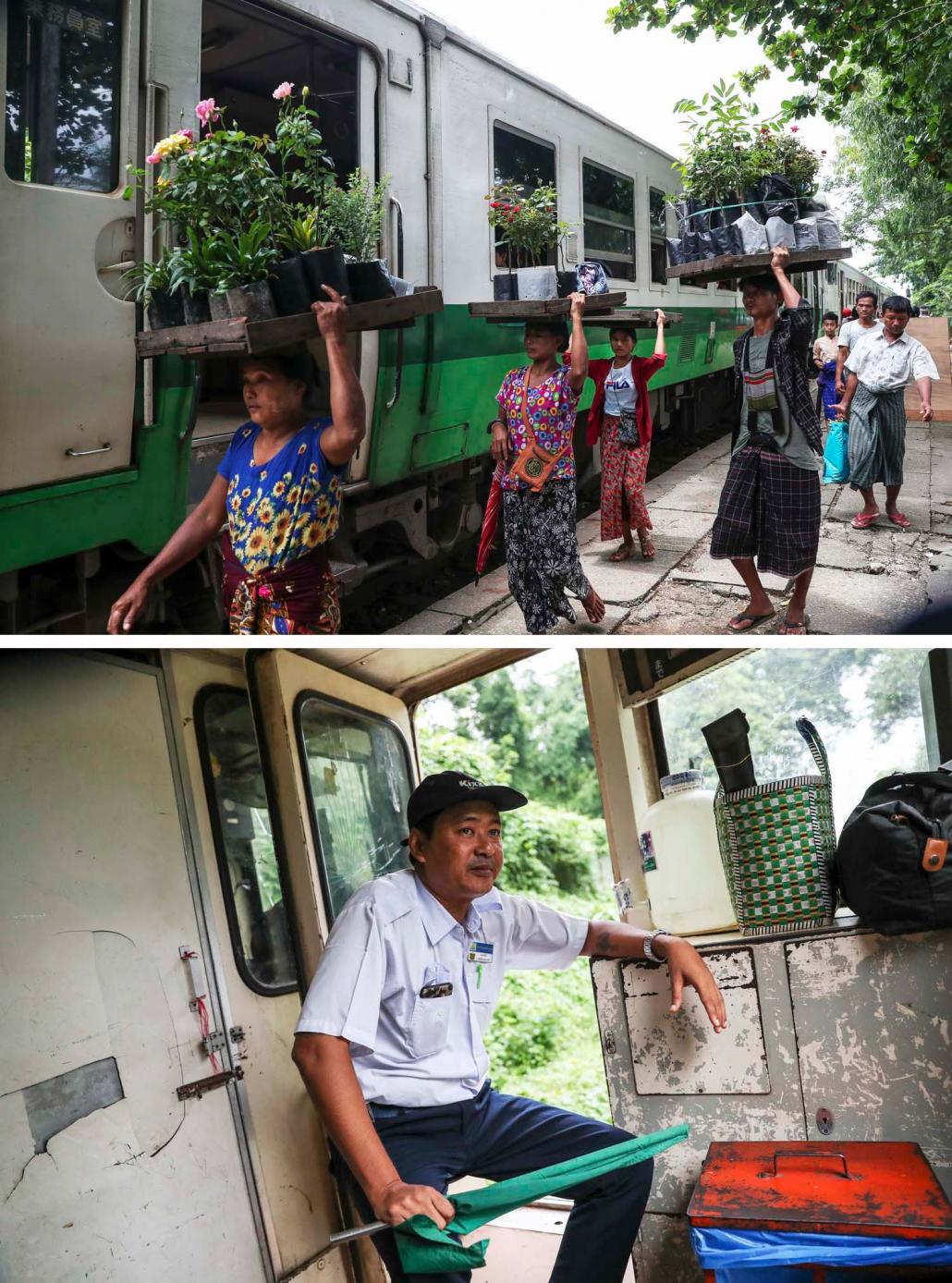
Plants are carried along the platform at Paywetseikkan Station in the city’s northeast (top) and a guard waits to jump out at the next platform. (Nyein Su Wai Kyaw Soe | Frontier)
Down the line
The original Yangon Budagyi, or main railway station, was built under colonial rule in 1877. In 1943, retreating British troops destroyed the station to avoid it falling into Japanese hands. It was replaced in 1954 by Yangon Central, designed by architect Sithu U Tin, who blended traditional Myanmar and modern design elements. In 1996, the government designated the station as one of Yangon’s landmark buildings.
Another two stations – Insein, built in 1865 according to Myanma Railways officials, and Kyimyindaing, built in 1928 – are also admired for their heritage architecture. Insein station, roofed with British tiles made more than 150 years ago, is a source of pride to the station master, U Nay Win. “The building is unchanged, except for being painted. The tiles and bricks are thick and the pillars are strong and massive,” he told Frontier.
Unfortunately, the building has not been well maintained and its condition is deteriorating.
Stations on the western side of the line are near commercial centres. They include the Phaya Lan (Pagoda Road) station near famous Bogyoke Market, and Pyay Lan (Pyay Road) station, which is near the Sein Gay Har and Taw Win Centre shopping malls and is a short walk to the National Museum.
The tracks near Mahlwagon station, two stations east of Yangon Central in Mingalar Taung Nyunt Township, have a connection to the dramatic events of 1988. Soon after the Tatmadaw seized power and began the brutal suppression of the pro-democracy movement, political activists would meet there to share information. The tradition continues and at dusk young people can be seen converging on the tracks near the station to discuss politics.
The suburban stations on the eastern side of the line gradually give way to industrial estates and plots of land, in attractive shades of green during the rainy season, where rice and vegetables are grown.
Paywetseikkan station in the city’s northeast is close to Yangon International Airport. Many have lamented that the airport is not actually connected to the line, though there are tentative plans for a link. U Arkar Min Thu, economic manager of the Circular Railway, said Myanma Railways was considering a project to build a link to Yangon International Airport starting in 2022, but plans were yet to be finalised.
Danyingon station in the north is notable for a fresh vegetable market on both sides of the tracks, similar to the Maeklong Railway Market on the southeastern outskirts of Bangkok – minus the hordes of tourists, of course. Hundreds of vendors line each side of the tracks, but the bustling market attracts few foreigners, perhaps because it is dirty and crowded.
The Yangon City Development Committee and the Ministry of Transport and Communications (which includes the departments that formerly constituted the Ministry of Rail Transportation) seem to be more interested in removing the vendors than making the market attractive to visitors. In the first week of June, YCDC announced that the vendors would be relocated to a newly built two-storey market near the station.
3_nswks1.jpg
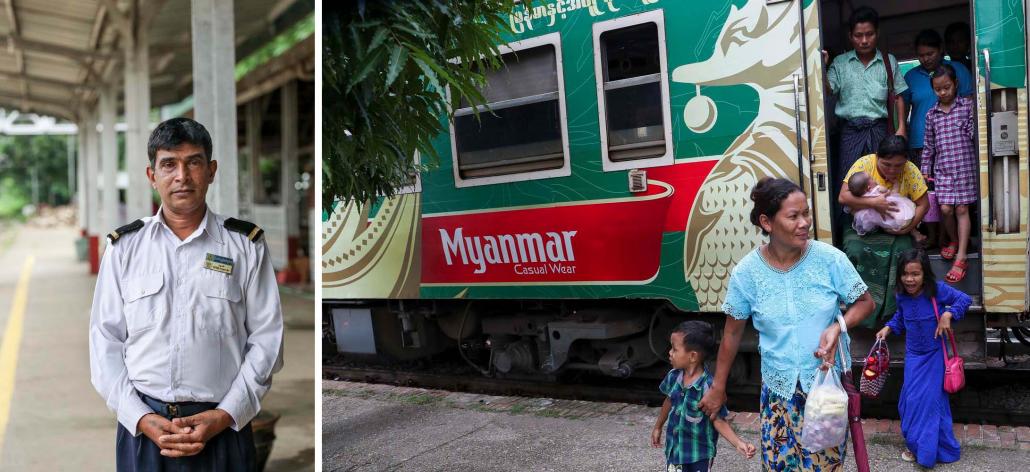
The heritage architecture of Insein station is a source of pride to the station master U Nay Win (left) and passengers disembark from a train. (Nyein Su Wai Kyaw Soe | Frontier)
A moveable market
Although the Circular Railway’s role is to transport passengers, it also supports the livelihoods of thousands of vendors, who ply their wares as carriages roll along the line.
The Circular Railway’s Transportation Department estimates that about 2,000 vendors make a living on the line, despite being in breach of the 2016 Rail Carriers’ Law. Section 73 of the law provides for anyone convicted of selling goods on a train to be fined up to K30,000.
However, for many decades, vendors and the Circular Railway have been inseparable. Many sell snacks, including boiled eggs, fried tofu, seasonal fruits and traditional favourites such as mote let kauk (donuts made from rice) and mote lone gyi (a rice ball snack).
Most vendors live in the suburbs and some of them rely on the Circular Railway to travel to busy neighbourhoods and markets, such as Mingalar Zay in Mingalar Taung Nyunt Township and Theinggyi Zay in downtown Pabedan Township, to hawk their wares.
The vendors are of all ages; in some families, every member sells items to passengers on the train. “In the past I sold pineapple with my father, but now I sell separately, which means we can make more money,” said Mg Zin Maung, seven, who sells limes on the train.
It is essential that vendors know the Circular Railway timetable by heart, because they need to know when a train arrives at a station to maximise selling opportunities.
4_nswks-26.jpg
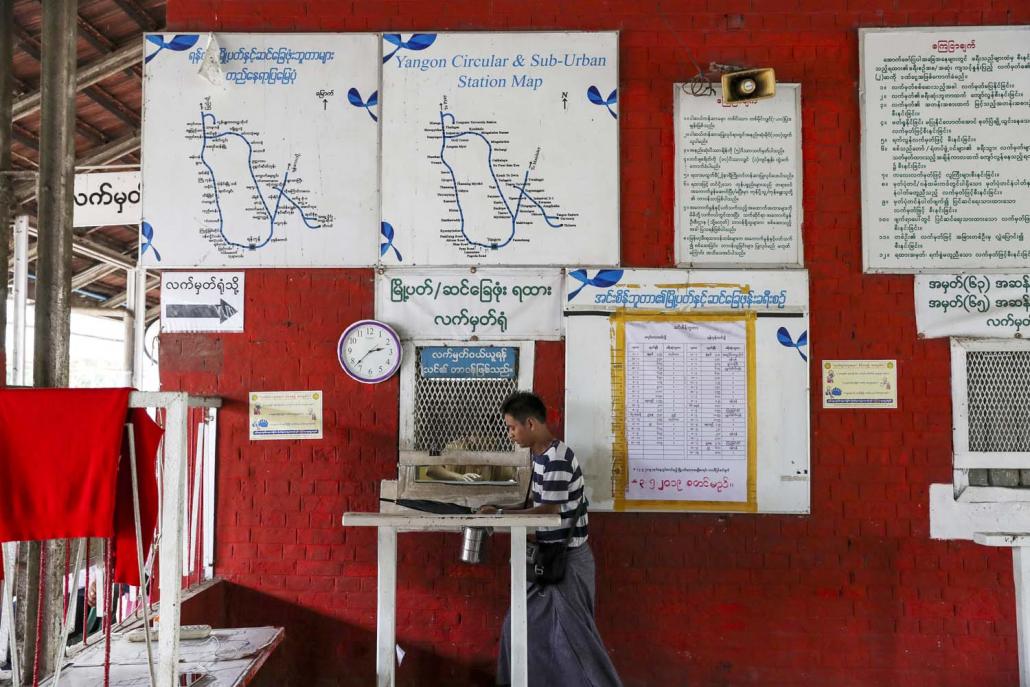
Timetables are displayed at Insein Station. (Nyein Su Wai Kyaw Soe | Frontier)
However, flexibility is required because of late trains and frequent timetable changes, which are usually the result of old rolling stock and track repairs.
“The arrival and departure times are not regular and the timetable changes often, but you need to know it and you also need to know which train carries more people, so you can sell more,” said Ma Win Cho, who has been selling a selection of traditional salads on the line for more than five years.
Vendors are not the only passengers who carry goods on the train. It is not unusual to see passengers using the train the transport bulky objects, such as wardrobes. Foragers often board the train in the downtown area lugging big plastic bags of discarded products that they take to recycling depots in the suburbs.
Myanma Railways has repeatedly announced crackdowns aimed at preventing vendors and beggars from using the Circular Railway but arrests are rarely made. Traffic manager Zaw Lwin said there is no record of a vendor having been fined as a result of a complaint by Myanma Railways.
After the Rail Carriers’ Law was enacted in 2016, the Ministry of Transport and Communications launched more than 20 attempts in two years to evict vendors from trains, but they have all been ineffective.
Zaw Lwin says vendors tarnish the image of Myanma Railways because they are “undisciplined” and disturb other passengers.
“It is not good to have people on the train who are lacking in discipline; our intention is to make these people fade away,” agreed U Htun Aung Thin, manager of Myanma Railways for Lower Myanmar.
Circular Railway officials say the number of vendors on the train network has risen as the economy has declined, but were unable to provide figures.
“We can’t control the vendors under the current system, but planned upgrades will mean that the vendors will have to stop selling on trains,” Zaw Lwin said.
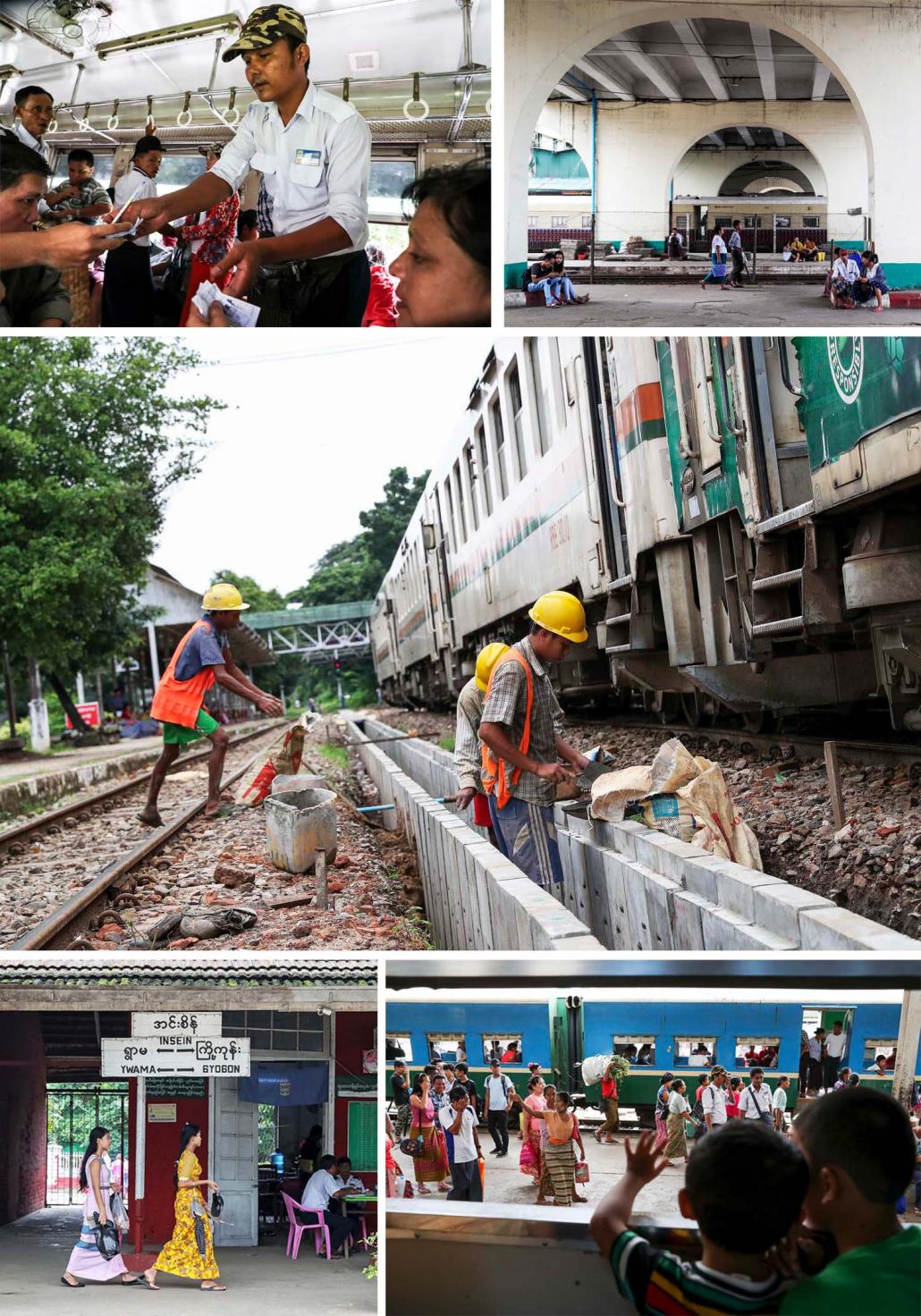
Nyein Su Wai Kyaw Soe | Frontier
A new dawn?
Plans for a sweeping upgrade of the Circular Railway in cooperation with Japan were first proposed in 2014. Initial estimates put the cost at up to $700 million, but the upgrade has since been scaled back to around $300 million. At the request of the Myanmar government, it was divided into two components, one covered by a soft loan.
A $206 million official development assistance loan from the Japan International Cooperation Agency is being used to buy 11 diesel-electric multiple unit (DEMU) trains with six carriages each, to replace the line’s diesel-powered rolling stock, as well as for installing signalling systems and providing technical assistance. Speaking at a news conference in February, Htun Aung Thin said Myanma Railways had chosen the hybrid DEMU trains because it could not afford to electrify the Circular Railway system.
Meanwhile, a $94 million government allocation to Myanma Railways is being spent on upgrading tracks and stations and building flyovers at level crossings.
The process of selecting contractors has taken much longer than expected, however. Following a tender, a consortium of A1 Construction and China’s Sinohydro was awarded the contract to upgrade the western section of the line, while Shwe Taung and Tokyu Construction are upgrading the eastern section.
But lengthy negotiations with the two consortiums over their bids delayed the signing of the contracts, Deputy Minister for Construction U Kyaw Myo told the Pyithu Hluttaw last December. He said work was due to begin in 2017 but did not get underway until March 2018. As a result, the Ministry of Transport and Communications has been forced to push back the scheduled completion date to at least 2022, after initially forecasting work would finish in 2020.
The upgrade work has resulted in parts of the line being shut down and services being reduced. On the eastern portion, Shwe Taung has closed seven stations from Danyingone to Okkalapa, meaning that trains are unable to complete a full loop. On the western side, work is being undertaken on one side of the dual track line, enabling Myanma Railways to continue limited operations. Speaking in February, Htun Aung Thin had said the seven stations would only be closed until July, but they are yet to reopen to services.
Once completed, the upgrade is expected to cut travel time for a full loop of the line from 170 minutes to 105 minutes; trains will run every 10 to 12 minutes at peak hour, and hit speeds of up to 60 kilometres an hour. Myanma Railways predicts that the number of passengers using the line will more than triple to nearly 300,000 by 2022, which Htun Aung Thin says will be made possible by more frequent services and an increase in the number of trains.
5_nswks-32.jpg
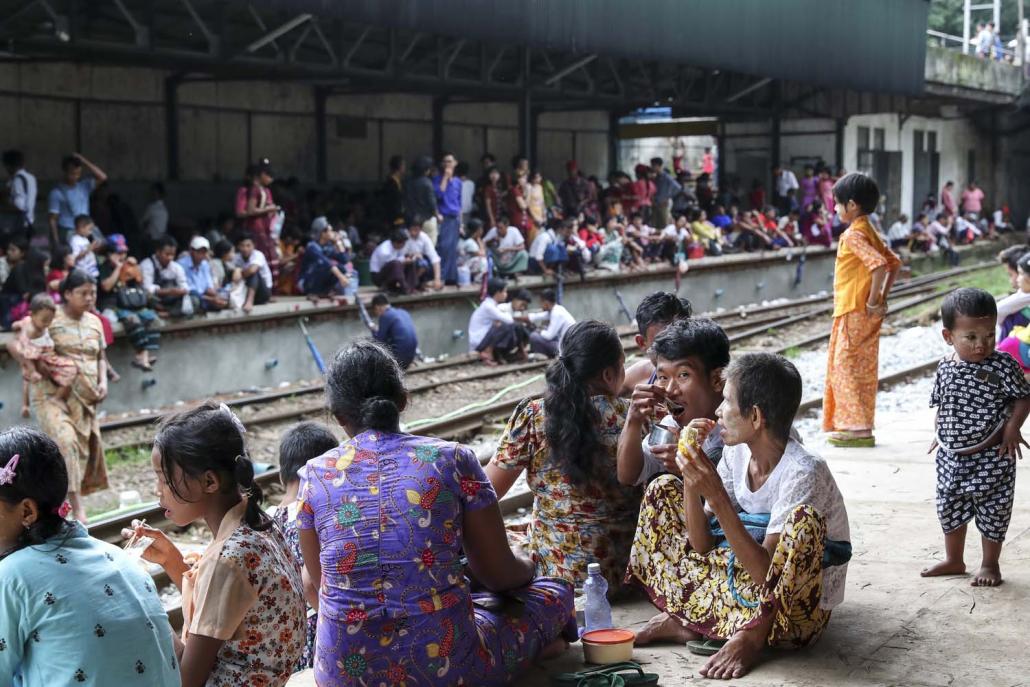
Passengers wait for the train at Phaya Lan (Pagoda Road) station. (Nyein Su Wai Kyaw Soe | Frontier)
Traffic manager Zaw Lwin says it is essential to plan for change. “Yangon will be a megacity in 2022 with a population of more than eight million and we will need an efficient train system,” he said.
However, some doubt the capacity of Myanma Railways to efficiently deliver on promises of improved services. In 2014, it pledged to introduce air-conditioned Rail Bus Engine trains from Japan and while the trains went into service in 2015, passengers were disappointed to find that the air-conditioning had malfunctioned by the following year.
Commuters who rely on the Circular Railway will be hoping that the upgrade delivers a more comfortable ride. But some travellers are sceptical.
“I must say that MR has not been able to move forward and is still out of date,” said U Tin Aye Yi, a retired judge and occasional train user. He believes that the line would attract more passengers if the appearance of trains and stations was improved.
Ma Hnin Aye Wai, who regularly commutes on the Circular Railway, said she wanted to see upheaval on the network along the lines of the Yangon Bus Service, which the Yangon Region government launched in January 2017.
“Over the past decade we’ve seen several projects launched to improve the Circular Train, but each time nothing changed – it’s still an uncomfortable journey for commuters,” she said.
But Zaw Lwin insisted this time things would be different and commuters would eventually enjoy a modern train network. The amount being invested dwarfed earlier attempts to improve services, he said. “We’re more aware of our own weaknesses than anyone else,” he said. “I can’t promise everything will be perfect, but I can promise that in 2022 there will be a better circular train system for the people.”


